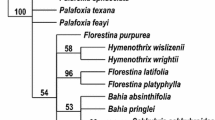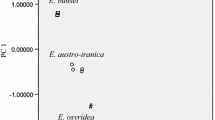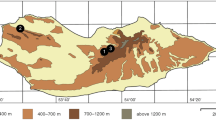Abstract
Nucleotide sequences from the internal transcribed spacers (ITS) of nuclear ribosomal DNA and 5.8S gene were used to infer the phylogeny of Tilia species (represented by 13 distinct populations) growing in different geographical areas of Hyrcanian forests in northern Iran. Four well-supported lineages were revealed, including that of a new species, T. hyrcana, with stellate trichomes on both sides of the leaves and petiole. T. hyrcana is a well-supported cladospecies, with the ITS sequence and secondary structure following the diagnosable phylogenetic species concept, and is also characterized by a distinct morphology. A controversial species is Tilia rubra subsp. caucasica, with three different forms—an assemblage of taxa characterized by a lack of stellate trichomes on leaves—while Tilia begonifolia is distinguished by stellate trichomes on the underside of both leaves and petiole. The fourth lineage group, T. dastyla, is characterized by the presence of trichomes on the style. A single taxon found in the west of the Hyrcanian forest region is similar to T. begonifolia, but due to the former being located in a distinct group, a reassessment of the diagnostic morphology is recommended. ITS sequence data also suggested a closer relationship between T. rubra and T. begonifolia. Compensatory base change analysis was not strong enough to separate individual species within the Tilia genus. In general, the study supports the utility of ITS sequence data and secondary structure as accessory taxonomic characteristics with which to help clarify the systematics of the Tilia genus.




Similar content being viewed by others
References
Aleshin VA, Kedrova OS, Milyutina IA, Vladychenskaya NS, Petrov NB (1998) Secondary structure of some elements of 18S rRNA suggests that strongylid and apart of rhabditid nematodes are monophyletic. FEBS Lett Evol 429:4–8
Alvarez I, Wendel JF (2003) Ribosomal ITS sequences and plant phylogenetic inference. Mol Phylogenet Evol 29:417–434
Alverson WS, Whitlock BA, Nyffeler R, Bayer C, Baum DA (1999) Phylogeny of the core Malvales: evidence from ndhF sequence data. Am J Bot 86:1474–1486
Anderson GJ (1976) Pollination biology of Tilia. Am J Bot 63:1203–1212
Ashokan KV, Pillai MM, Angadi SM, Mundaganur DS (2009) Sequence comparison of the ribosomal DNA internal transcribed spacers (ITSs) and 5.8S ribosomal gene and their secondary structures in 17 Pteriomorphian bivalves. Int J Genom Proteom 5(1):4–20
Baldwin BG (1992) Phylogenetic utility of the internal transcribed spacer of nuclear ribosomal DNA in plants: an example from the compositae. Mol Phylogenet Evol 1:3–16
Baldwin BG, Sanderson MJ, Porter JM, Wojciechowski MF, Campbell CS, Donoghue MJ (1995) The ITS region of nuclear ribosomal DNA: a valuable source of evidence on Angiosperm phylogeny. Ann Mo Bot Gard 82:247–277
Billoud B, Guerrucci M, Masselot M, Deutsch JS (2000) Cirripede phylogeny using a novel approach: molecular morphometrics. Mol Biol Evol 17:1435–1445
Bremer B, Bremer K, Chase MW, Fay MF, Reveal JL, Soltis DE, Soltis PS, Stevens PF (2009) An update of the Angiosperm Phylogeny Group classification for the orders and families of flowering plants: APGIII. Bot J Linn Soc 161(2):105–121
Browicz K (1981) Tiliaceae. In: Rechinger KH (ed) Flora Iranica, vol 148. Akademische Druck, Graz-Austria, pp 1–15
Brunner S, Brodbech U, Buchler U, Sperisen C (2001) Molecular identification of fine roots of trees from Alps: reliable and fast DNA extraction and PCR-RFLP analyses. Mol Ecol Evol 10:2079–2087
Coleman AW, Mai JC (1997) Ribosomal DNA ITS-1 and ITS-2 sequence comparisons as a tool for predicting genetic relatedness. J Mol Evol 45:168–177
Coskun F (2003) The phylogeny and biogeography of Osmanthus, Cercis and Tilia based on ITS nuclear ribosomal, ndhf and trn L-F chloroplast DNA sequence data. Dissertation, University of North Carolina
Davis JI, Nixon KC (1992) Populations, genetic variation, and the delimitation of phylogenetic species. Syst Biol 41:421–435
Dellaporta SL, Wood J, Hicks JB (1983) A plant DNA minipreparation: version II. Plant Mol Biol Rep 1:19–21
Doyle JJ, Doyle JL (1987) A rapid DNA isolation procedure for small quantities of fresh leaf tissue. Phytochem Bull Evol 19:11–15
Eisenhut G (1957) Blühen, Fruchten und Keimen in der Gattung Tilia. Dissertation, University of München
Fineschi S, Carnevale S, Salvini D, Turchini D, Vendramin GG (2003) Chloroplast DNA variation of Tilia cordata Mill. Can J Forest Res 33:2503–2508
Fromm M, Hattemer HH (2003) Inheritance of allozymes and hybridisation in two European Tilia species. Heredity 91:337–344
Fromm M (2001) Reproduktion einer entomophilen Baumart in geringer populationsdichte-Das Beispiel der Winterlinde (Tilia cordata Mill). Dissertation, Universtität Göttingen
Gharaman A (1993) Choromophytes of Iran (Plant systematics). Tehran University Press, Tehran
Gottschling M, Hilger HH, Wolf M, Diane N (2001) Secondary structure of the ITS1 transcript and its application in a reconstruction of the phylogeny of Boraginales. Plant Biol 3:629–636
Hall C, Welch J, Kowbel DJ, Glass NJ (2010) Evolution and diversity of a fungal self/non self recognition locus. PLoS One 5:e14055
Harris DJ, Crandall KA (2000) Intragenomic variation with in ITS1 and ITS2 of freshwater crayfishes (Decapoda: Cambaridae): implications for phylogenetic and microsatellite studies. Mol Biol 17:284–291
Harris SA, Ingram R (1991) Plastid DNA and biosystematics: the effect of intraspecific diversity and plastid transmission. Taxon 40:393–412
Hershkovitz MA, Zimmer EA (1996) Conservation patterns in angiosperm rDNA ITS2 sequences. Nucleic Acids Res 24:2857–2867
Ito E, Kikuzawa K (1999) Cryptic andromonoecy in Tilia japonica implicated by flower abortion. Plant species Biol 14:193–199
Jobes DV, Thien LB (1997) A conserved motif in the 58S ribosomal RNA (rRNA) gene is a useful diagnostic marker for plant internal transcribed spacer (ITS) sequences. Plant Mol Biol Rep 15:326–334
Khosroshahi M, Ghavvami S (2006) Warning, the conservation of nature. Poone Publishing, Tehran
Kimura M (1980) A simple method for estimating evolutionary rate of base substitutions through comparative studies of nucleotide sequences. J Mol Evol 16:111–120
Kinney MS, Columbus JT, Friar EA (2003) Molecular evolution of the maize sex-determining gene TASSELSEED2 in Bouteloua (Poaceae). Mol Phylogenet Evol 29:519–528
Kjer KM (1995) Use of rRNA secondary structure in phylogenetic studies to identify homologous positions: An example of alignment and data presentation from the frogs. Mol Biol Evol 4:314–330
Krüger D, Gargas A (2008) Secondary structure of ITS2 ribosomal RNA provides taxonomic characters for systematic studies—a case in Lycoperdaceae (Basidiomycota). Mycol Res 112:316–330
Kumar S, Gadagkar SR (2001) Disparity index: a simple statistic to measure and test the homogeneity of substitution patterns between molecular sequences. Genetics 158:1321–1327
Leestmans R (2005) Le refuge caspiens et son importance en biogéographie. Linn Belg Evol 20:97–102
Liesebach H, Sinko Z (2008) A contribution to the systematics of the genus Tilia with respect to some hybrids by RAPD analysis. Dendrobiology 59:13–22
Liu JS, Schardl CL (1994) A conserved sequence in internal transcribed spacer 1 of plant nuclear rRNA genes. Plant Mol Biol 26:775–778
Mai JC, Coleman AW (1997) The internal transcribed spacer 2 exhibits a common secondary structure in green algae and flowering plants. J Mol Evol 44:258–271
Maleev VP (1949) Tilia. In: Komarov VL, Schischkin BK, Bobrov EG (eds) Flora of the USSR. Academy of sciences, Moscow/Leningrad
Maurer WD, Tabel U (1995) A methodical study to improve the allozyme analysis for identification of clones of Tilia. Silvae Genet Evol 44:351–356
Muller T, Philippi N, Dandekar T, Schultz J, Wolf M (2007) Distinguishing species. RNA Evol 13:1469–1472
Mullineux T, Hausner G (2009) Evolution of rDNA ITS1 and ITS2 sequences and RNA secondary structures within members of the fungal genera Grosmannia and Leptographium. Fungal Genet Biol 46:855–867
Nazar RN, Wong WM, Abrahamson JLA (1987) Nucleotide sequence of the 18–25S ribosomal RNA intergenic region from a thermophile, Thermomyces lanuginosus. J Biol Chem 262:7523–7527
Nei M (1987) Molecular evolutionary genetics. Columbia University Press, New York
Nilsson RH, Kristiansson E, Ryberg M, Hallenberg N, Larsson KH (2008) Intraspecific ITS variability in the kingdom fungi as expressed in the international sequence databases and its implications for molecular species identification. Evol Bioinform Evol 8:193–201
Nixon KC, Wheeler QD (1990) An amplification of the phylogenetic species concept. Cladistics 6:211–223
Olivier C, van de Pas S, Lepp PW, Yoder K, Relman DA (2001) Sequence variability in the first internal transcribed spacer region within and among Cyclospora species is consistent with polyparasitism. Int J Parasitol 31:1475–1487
Page RD (1996) Tree view: an application to display phylogenetic trees on personal computers. Comput Appl Biosci Evol 12:357–358
Paw UKT, Hotton C (1989) Optimum pollen and female receptor size for anemophily. Am J Bot 76:445–453
Pigott CD, Francis B (1999) The taxonomic status of Tilia dasystyla in Crimea, Ukraine. Edinb J Bot Evol 56:161–173
Rajora OP, Dancik BP (1992) Genetic characterisation and relationships of Populus alba, P. tremula and P.x canescens, and their clones. Theor Appl Genet 84:291–298
Sabeti H (1976) Forests, trees and shrubs of Iran. Agriculture and Natural Resources Research organization Publications, Tehran
Schill RO, Förster F, Dandekar T, Wolf M (2010) Using compensatory base change analysis of internal transcribed spacer 2 secondary structures to identify three new species in Paramacrobiotus (Tardigrada). Org Divers Evol 10:287–296
Schlotterer C, Hauser MT, von Haeseler A, Tauz D (1994) Comparative evolutionary analysis of rDNA ITS regions in Drosophila. Mol Biol Evol 11:513–522
Schultz J, Maisel S, Gerlach D, Muller T, Wolf M (2005) A common core of secondary structure of the internal transcribed spacer 2 (ITS2) throughout the Eukaryota. RNA 11:361–364
Schumann K (1897) Tiliaceae. In: Engler A, Prantl K (eds) Die natürlichen Pflanzenfamilien. Nachträge zu, Leipzig, pp 232–234
Seibel PN, Müller T, Dandekar T, Schultz J, Wolf M (2006) 4SALE-a tool for synchronous RNA sequence and secondary structure alignment and editing. BMC Bioinform 13(7):498
Seibel PN, Müller T, Dandekar T, Wolf M (2008) Synchronous visual analysis and editing of RNA sequence and secondary structure alignments using 4SALE. BMC Res Notes 1:91. doi:10.1186/1756-0500-1-91
Selig C, Wolf M, Müller T, Dandekar T, Schultz J (2008) The ITS2 Database II: homology modeling RNA structure for molecular systematic. Nucleic Acids Res 36:377–380
Shishkin BK, Bobrov EG (eds) (1949) Tilia in V. L. Komarov Flora USSR, vol. 15. Nauka, Moskva-Leningrad, pp 2–23
Steel RGD, Torrie JH (1980) Principles and procedures of statistics, 2nd edn. McGraw-Hill Book Company, New York
Steven C (1832) Observationes in plantas rossicas et descriptiones specierum novarum. Bjull Moskovsk Obsc Isp Prir, Otd Biol 4:259–264
Subbotin SA, Sturhan D, Vovlas N, Castillo P, Tambe JT, Moens M, Baldwin JG (2007) Application of the secondary structure model of rRNA for phylogeny: D2–D3 expansion segments of the LSU gene of plant-parasitic nematodes from the family Hoplolaimidae Filipjev, 1934. Mol Phylogenet Evol 43:881–890
Suh YB, Thien LB, Zimmer EA (1992) Nucleotide sequences of the internal transcribed spacers and 58S rRNA gene in Canella winterana (Magnoliales; Canellaceae). Nucleic Acids Res 20:6101–6102
Swofford DL, Olsen GJ, Waddel PJ, Hillis DM (1996) Phylogenetic inference. In: Hillis DH, Moritz C, Mable BK (eds) Molecular systematics, 2nd edn. Sinauer Associates, Sunderland, pp 407–514
Tajima F (1989) Statistical method for testing the neutral mutation hypothesis by DNA polymorphism. Genetics Evol 123:585–595
Tajima F (1993) Simple methods for testing the molecular evolutionary clock hypothesis. Genetics 135:599–607
Tamura K, Dudley J, Nei M, Kumar S (2007) MEGA4: Molecular Evolutionary Genetics Analysis (MEGA) software version 4. Mol Biol Evol 24:1596–1599
Torres RA, Ganal M, Hemleben V (1990) GC balance in the internal transcribed spacers ITS1 and ITS2 of nuclear ribosomal RNA genes. J Mol Evol 30:170–181
Tralau H (1963) Asiatic dicotyledonous affinities in the Cainozoic flora of Europe. Kungl Svenska Vetens Handl 9(3):1–87
Weekers PHH, De Jonckheere JF, Dumont HJ (2001) Phylogenetic relationships inferred from ribosomal ITS sequences and biogeographic patterns in representative of the genus Calopteryx (Insecta: Odonata) of the West Mediterranean and adjacent West European zone. Mol Phylogenet Evol 20:89–99
Wheeler QD, Platnick NI (2000) The phylogenetic species concept (sensu Wheeler and Platnick). In: Wheeler QD, and Meier R (eds) Species concepts and phylogenetic theory. Columbia University Press, New York, pp 55–69
White TJ, Bruns T, Lee S, Taylor JW (1990) Amplification and direct sequencing of fungal ribosomal RNA genes for phylogenetics. In: Innis MA, Gelfand DH, Sninsky JJ, White TJ (eds) PCR protocols: a guide to methods and applications. Academic Press, Inc., NY, pp 315–322
Wolf M, Friedrich J, Dandekar T, Müller T (2005) CBC analyzer: inferring phylogenies based on compensatory base changes in RNA secondary structures. In Silico Biol 5:291–294
Won H, Renner SR (2005) The chloroplast trnT–trnF region in the seed plant lineage gnetales. J Mol Evol 61:425–436
WWF World Wide Fund (2001) Caspian Hyrcanian mixed forests. Available in http://www.worldwildlife.org/wildworld/profiles/terrestrial/pa/pa0407_full.html#cites
Yokota Y, Kawata T, Iida Y, Kato A, Tanifuji S (1989) Nucleotide sequences of the 58SrRNA gene and internal transcribed spacer regions in carrot and broad bean ribosomal DNA. J Mol Evol 29:294–301
Yousefzadeh H, Tabari M, Hosseinzadeh Colagar A, Assadi M, Sattarian A (2010a) Morphotypes of Tilia spp. fruits in Hyrcanian forests. Rostaniha 11(1):43–53
Yousefzadeh H, Tabari M, Hosseinzadeh Colagar A, Assadi M, Sattarian A, Zare H (2010b) Variation in Leaf Morphology of Tilia spp. of in Hyrcanian forests. J Taxon Biosyst 2(3):11–24
Yousefzadeh H, Hosseinzadeh Colagar A, Tabari M, Sattarian A, Assadi M (2010c) Recognition of different stomata types of Tilia spp. in Hyrcanian forests. J Taxono Biosyst 2(5):17–28
Zohary M (1973) Geobotanical foundation of the Middle East, vol 1–11. Gustav Fische, Stuttgart
Zomlefer WB, Judd WS (2008) Two new species of Schoenocaulon (Liliales: Melanthiaceae) from Mexico supported by ITS sequence data. Syst Bot 33(1):117–124
Acknowledgments
We are tremendously grateful to Dr. N. Tippery, Department of Ecology and Evolutionary Biology, University of Connecticut, USA; Dr. G. Feliner, Real Jardín Botánico, CSIC, Spain; Dr. J. Graham, Berry College, Mount Berry, GA, USA; and Dr. LLJG. van der Maesen, Biosystematics Group, Wageningen University, The Netherlands, for their reviewing and providing helpful comments that contributed to making this manuscript significantly better.
Author information
Authors and Affiliations
Corresponding author
Rights and permissions
About this article
Cite this article
Yousefzadeh, H., Hosseinzadeh Colagar, A., Tabari, M. et al. Utility of ITS region sequence and structure for molecular identification of Tilia species from Hyrcanian forests, Iran. Plant Syst Evol 298, 947–961 (2012). https://doi.org/10.1007/s00606-012-0604-x
Received:
Accepted:
Published:
Issue Date:
DOI: https://doi.org/10.1007/s00606-012-0604-x




